In the dynamic world of digital marketing, Facebook has evolved from traditional pixel-based tracking to a more sophisticated, integrated framework known as datasets. This strategic shift enhances advertisers’ ability to track and analyse interactions across multiple channels, both online and offline.
Facebook’s datasets provide a comprehensive approach to data management, offering deeper insights into customer journeys and enabling highly targeted advertising strategies. These datasets work in conjunction with Facebook Ads AI to optimise campaigns further down the sales funnel, improving lead quality by focusing on prospects most likely to convert.
This guide will explore how to connect data sources, such as Web, Offline, and CRM funnel events, to your dataset. We will place particular emphasis on utilising CRM data sources, as this represents the most significant new capability in Facebook conversion tracking. Specifically, we will discuss how to improve lead quality and reporting, leverage rich insights, and refine marketing efforts from lead generation through to final sales conversions.
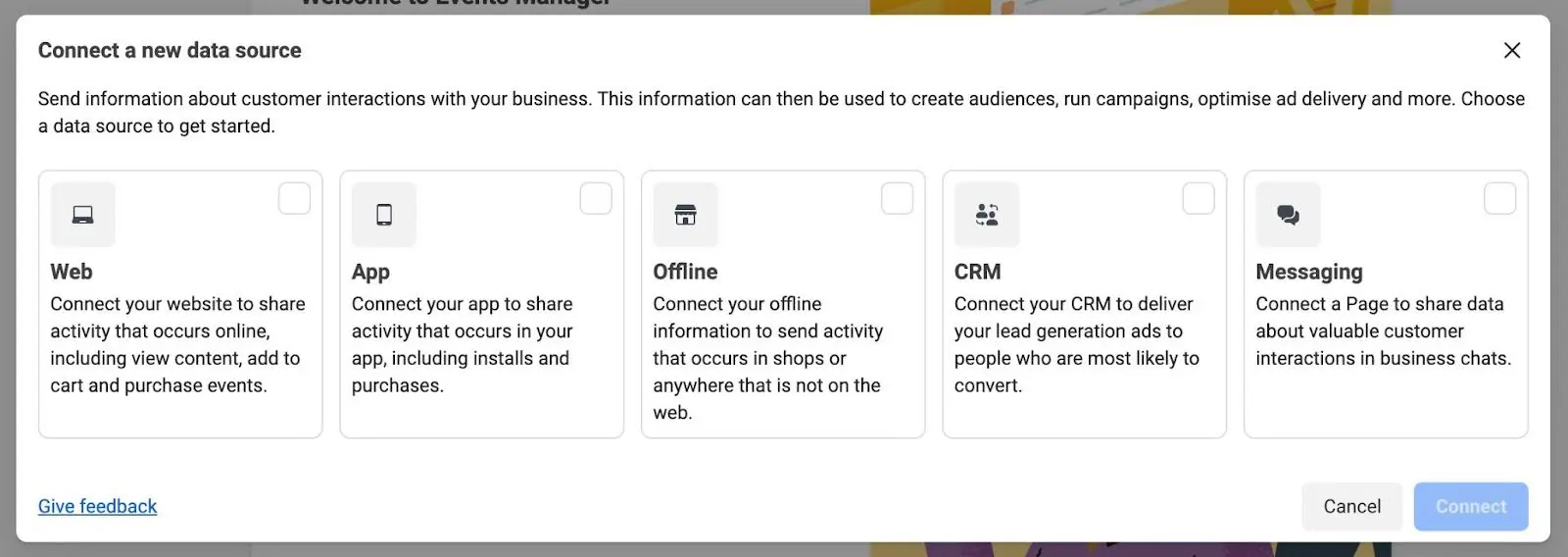
What Are Facebook Datasets?
Facebook datasets are an advanced measurement framework developed for tracking and analysing both online and offline user interactions. This system significantly enhances the robustness and flexibility compared to its predecessors( the pixel-based tracking and offline conversions), enabling a much more comprehensive integration of data from a variety of sources including websites, mobile apps, offline activities, and messaging platforms.
With the deployment of datasets, businesses gain the capability to monitor and evaluate user interactions on their websites after a user clicks on a Facebook ad. Furthermore, it allows for the tracking of user activities across multiple platforms, providing a holistic view of user engagement and behaviour. This multidimensional tracking is crucial for businesses aiming to understand the full impact of their online advertising and to refine their marketing strategies based on rich, actionable insights.
Moreover, Facebook datasets are designed to integrate seamlessly with leading CRMs and other marketing tools and systems, enhancing data synchronisation and workflow efficiency. This integration significantly boosts the efficacy of offline conversion tracking in conjunction with a CRM funnel, enabling a detailed analysis of the customer journey from initial engagement through to conversion.
Utilising these datasets, Facebook Ads AI can accurately measure lead quality by tracking offline conversions and optimise ad delivery for leads that show higher potential to become customers. This comprehensive approach not only refines targeting strategies but also maximises the return on investment.
By leveraging the insights gained from both online and offline interactions, businesses can more effectively identify and nurture leads that are most likely to convert, ensuring marketing efforts are precisely aligned with sales objectives and driving better overall outcomes.
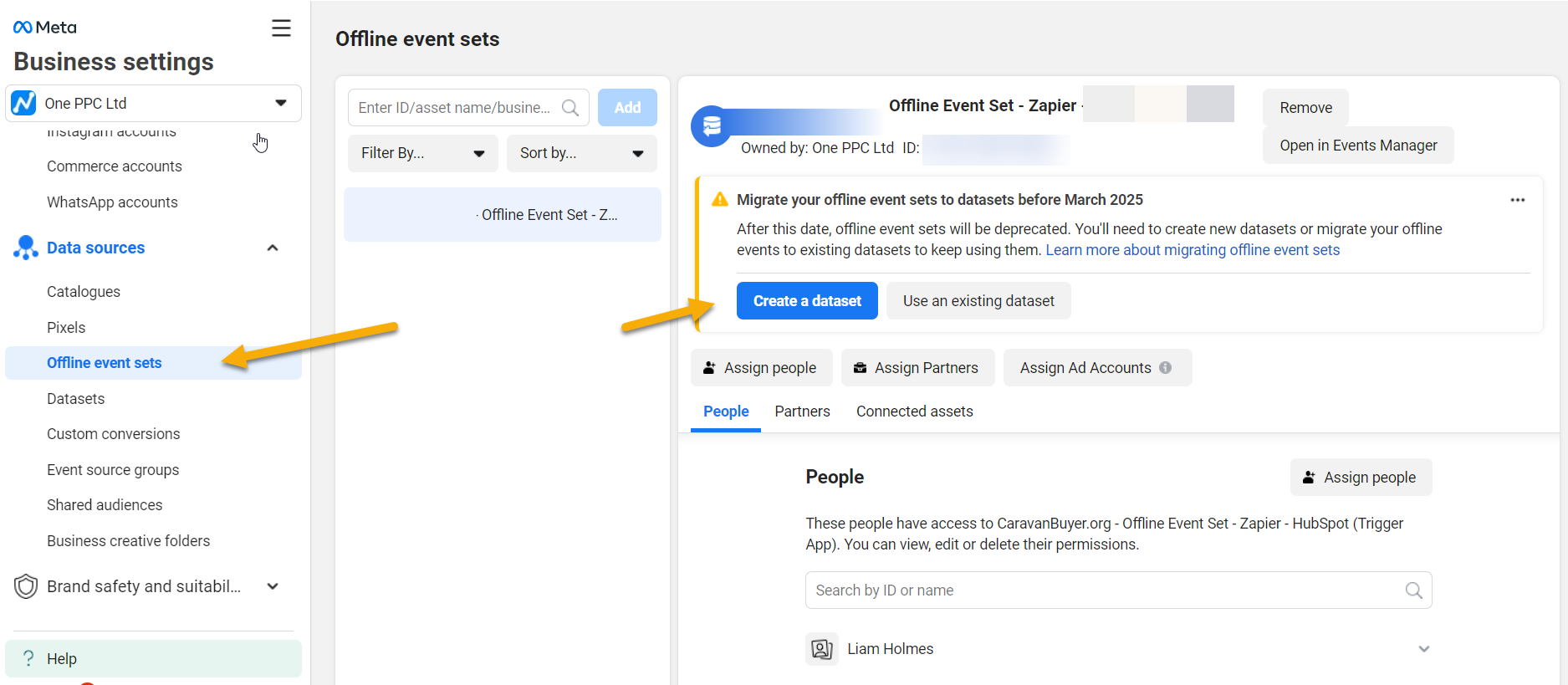
Key Differences Between Datasets and Pixels
Facebook originally had a different tracking and measurement toolset for online and offline conversion tracking. The Facebook Ads Pixel was for tracking online conversions, where offline events sets was for offline conversions. Datasets are now one tracking system to rule them all!
Flexibility and Integration: Datasets offer greater flexibility in tracking various types of user interactions and provide better integration with Facebook’s other advertising tools.
Data Management: Unlike pixels, datasets allow for improved data management capabilities, allowing you to connect data from different sources under one umbrella.
Comprehensive Data Integration: You can integrate data from your websites, apps, and offline activities seamlessly.
Simplified Management: Managing datasets involves a single API integration, replacing the need to manage multiple IDs for pixels, apps, and offline events.
Connect Data Sources to Your Datasets
Connect new data sources to send information about customer interactions with your business. This information can then be used to create audiences, run campaigns, optimise ad delivery, and more. There are several data sources you can integrate into your dataset. Choose a data source:
Web: This is similar to the legacy Facebook Ads Pixel that connect your website to share activity that occurs on your website, including view content, add to cart, initiate checkout and purchase events..
App: Connect your app to share activity that occurs in your apps, including installs and purchases
Offline: Connect your offline information to send activity such as sales that does not occur on your website or app. For example using Stripe as a POS (Point of Sale).
CRM: Connect your CRM to delivery your lead generation ads to people who are most likely to convert.
Messaging: Connect a page to share data about valuable customer interactions in business charts
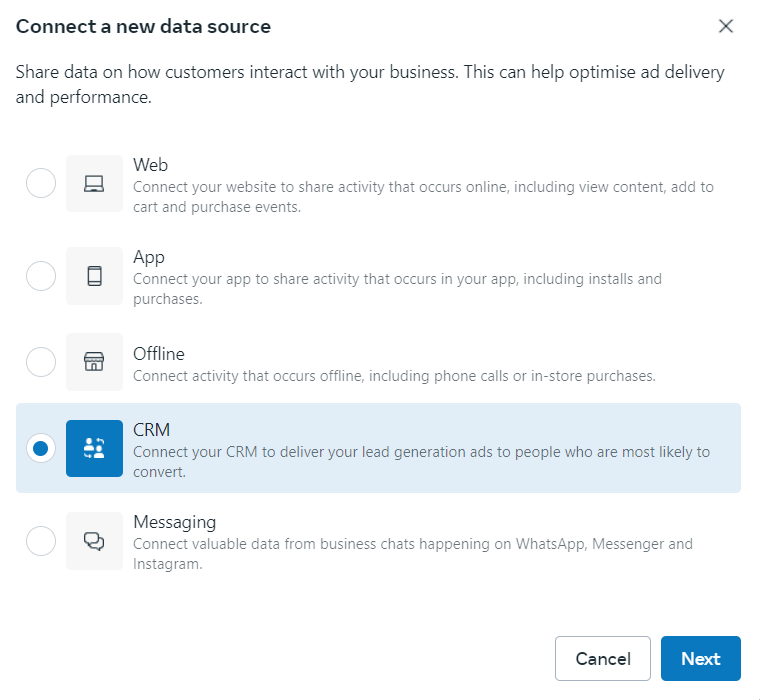
How to Create a Facebook Ads Dataset
Accessing Events Manager:
– Navigate to Meta Events Manager and select “Connect Data Sources” by clicking on the green plus sign.
– Choose the appropriate data source (Web, App, Offline, or Business Chat) and click “Connect”.
– Name your dataset and click “Create”.
Setting up in Business Manager:
– Log in to your Business Manager at business.facebook.com/select.
– Go to “Business Settings” and select “Event Manager”.
Click on “Connect Data” and choose “web” as your data source.
– After creation, provide details about your website and choose the “Do it yourself” option for setup.
– Note your dataset ID, which will function similarly to the old pixel ID.
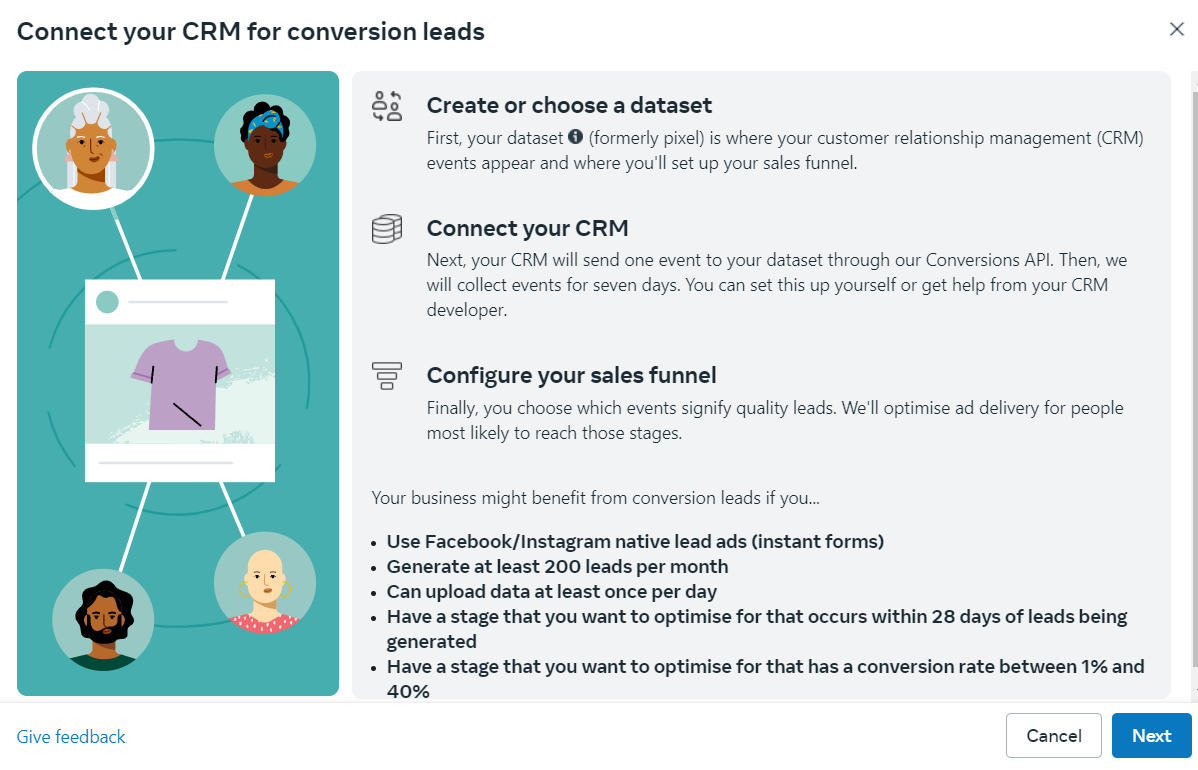
Creating a Dataset for Offline Events (CRM Funnel Events)
In today’s omnichannel marketing landscape, tracking offline events is crucial for businesses to get a complete picture of their customer journey. Meta’s dataset feature allows you to connect offline events to your online advertising efforts, providing valuable insights and improving ad targeting. Here’s an expanded guide on how to create and utilise a dataset for offline events.
Why Track Offline Events?
Before delving into the process, it’s important to understand the benefits of tracking offline events:
Holistic Customer View: Combine online and offline interactions for a comprehensive picture of the customer journey.
Improve Lead Quality: Train the Facebook Ads AI to optimise for lead quality by employing lead scoring via offline conversion tracking based on the steps of your CRM sales process.
Improved Attribution: Accurately attribute conversions that occur offline to your online adverts.
Enhanced Targeting: Use offline data to create more precise custom audiences.
Better ROI Measurement: Obtain a more accurate assessment of your overall marketing ROI. Save money on low quality leads and increase sales with higher quality leads.
What are CRM Funnel Events
Facebook Ads CRM Funnel events offer advertisers the capability to track and optimise for critical customer actions that occur within their CRM systems post-lead generation through Facebook Lead Ads. Here are the pivotal aspects of CRM Funnel events:
Two-Way Data Flow: CRM Funnel events facilitate a bidirectional data exchange between Facebook Ads and a company’s CRM system. This integration enables the Facebook algorithm to refine ad delivery based on downstream conversion events occurring within the CRM.
Examples of CRM Funnel Events:
- Lead qualification
- Scheduling of sales calls
- Deal closures
- Purchase completions
Setting Up CRM Funnel Events: To implement CRM Funnel events, advertisers need to:
- Create or select a Facebook pixel to monitor CRM events.
- Connect their CRM to the Facebook Conversions API.
- Define their sales funnel stages within Facebook.
Enhanced Accuracy with Conversions API: The Conversions API establishes a direct link between the CRM marketing data and Facebook’s systems, enhancing both the optimisation and measurement of ad campaigns.
Optimising Ad Delivery: Tracking CRM Funnel events enables Facebook to focus ad delivery on quality leads that show a higher likelihood of conversion further along the funnel, rather than merely optimising for the volume of leads.
Automation via Tools Like Zapier: Tools such as Zapier can be utilised to automate the transmission of funnel event data from a CRM to Facebook Conversions when new leads are captured through Lead Ads.
Insights and Strategic Advantages: Tracking these downstream events offers advertisers deeper insights into which adverts and targeting strategies are truly driving tangible business outcomes beyond mere lead generation. It also supports more sophisticated, funnel-based advertising strategies across the stages of awareness, consideration, and conversion.
Leveraging CRM Funnel Events for Effective Campaigns: By harnessing CRM Funnel events, advertisers can craft more impactful Facebook ad campaigns that not only generate qualified leads but also optimise for actual sales outcomes. The seamless integration between Facebook and CRM data provides a more comprehensive view of the customer journey, enhancing the overall effectiveness of digital marketing efforts.
Creating a Dataset for Offline Events
Follow these steps to create a dataset for offline events:
- Access Meta Events Manager.
- Look for the green plus sign and click “Connect data sources”.
- Choose “Offline” from the options presented.
- Click “Connect” to proceed.
- Provide a unique, descriptive name for your dataset. This name should help you easily identify it later when creating adverts or custom audiences.
- Click “OK” to finalise the creation.
- After creation, you can view event data by clicking on your dataset ID in Events Manager.
Configuring Your Offline Dataset
Once your dataset is created, you’ll need to configure it properly:
- In Events Manager, go to your dataset settings.
- Locate the “Linking” section.
- Click “Link” to connect additional data sources if needed.
- Follow the on-screen instructions to complete the linking process.
Uploading Offline Event Data
To make your offline dataset useful, you need to populate it with data:
- In Events Manager, select your offline dataset.
- Click on “Upload Events”.
- Choose between uploading a file or using the API for real-time data transfer.
- If uploading a file, ensure it’s in the correct format (CSV or TXT).
- Map your data columns to Meta’s event parameters.
- Upload your file and wait for Meta to process the data.
Configuring Up Your Sales Funnel inside Facebook
To fine-tune your advertising efforts and focus on the most productive stages of your sales funnel, follow these steps:
- Access Events Manager: Navigate to your Events Manager dashboard.
- Select Data Sources: Under ‘Data sources’, click on the pixel that is linked to your CRM.
- Verify Integration: If your integration is complete, click ‘Continue’. If there are any errors, resolve these before proceeding.
- Edit Events: To remove any events that are not relevant to your sales funnel, click the minus icon next to the event.
- Organise Events: For the events that remain, reorder them to reflect the typical progression of a lead through your sales funnel. Once organised, click ‘Next’.
- Choose Focus Stage: Tick the box next to the event that represents the earliest stage you wish to focus on. This stage will become the primary focus for improving the performance of your ads. Once selected, click ‘Next’.
- Complete Setup: Your sales funnel setup is now complete.
By tailoring your lead ads to include the conversion leads performance goal, this configuration will help you attract higher quality leads. This strategic approach ensures that your ads are delivered to individuals most likely to progress to your chosen stage of the sales funnel, enhancing the overall efficacy of your advertising campaigns.
Measuring Success
To gauge the effectiveness of your offline event tracking:
- Regularly review your offline event data in Events Manager.
- Compare online and offline conversion rates.
- Analyse the impact of offline data on your custom audience performance.
- Monitor changes in overall ROAS (Return on Ad Spend) after incorporating offline data.
By effectively setting up and utilising offline event datasets, you can bridge the gap between your online advertising efforts and offline business activities, leading to more informed decision-making and improved marketing performance.

Using Zapier for CRM Integration
If your CRM or business system does not have out of the box integration with Facebook Ads, Zapier is a great option to connect the systems. Want to learn more, reading our blog post – Using Zapier for Facebook Ads.
Using Datasets in Ad Campaigns
Datasets can enhance your ad campaigns by:
- Tracking Conversions: Monitor conversions across multiple platforms effectively.
- Creating Custom Audiences: Use comprehensive user data to form targeted audience segments.
- Optimising Ad Delivery and Performance: Leverage integrated insights to improve the delivery and effectiveness of your ads.
Best Practices for Using Datasets
Regular Monitoring: Check your dataset performance frequently in the Events Manager.
Custom Conversions: Establish custom conversions to track specific actions across all connected platforms.
Audience Segmentation and A/B Testing: Use the rich dataset information for precise targeting and to conduct thorough A/B tests on your ad campaigns.
Consistent Identifiers: Use consistent customer identifiers across online and offline touchpoints.
Regular Updates: Frequently update your offline event data for accurate reporting and targeting.
Data Quality: Ensure the accuracy and completeness of your offline data before uploading.
Privacy Compliance: Adhere to data privacy regulations when collecting and uploading customer data.
Leveraging Offline Data in Your Ad Campaigns Once your offline dataset is set up and populated, you can use it to:
Create Custom Audiences: Build audiences based on offline behaviours for targeted advertising.
Improve Ad Attribution: Get a more accurate picture of which adverts are driving offline conversions.
Optimise Ad Delivery: Allow Meta’s algorithm to use offline data to optimise ad delivery to users more likely to convert.
Retarget Offline Customers: Create campaigns specifically targeting customers who have interacted with your business offline.
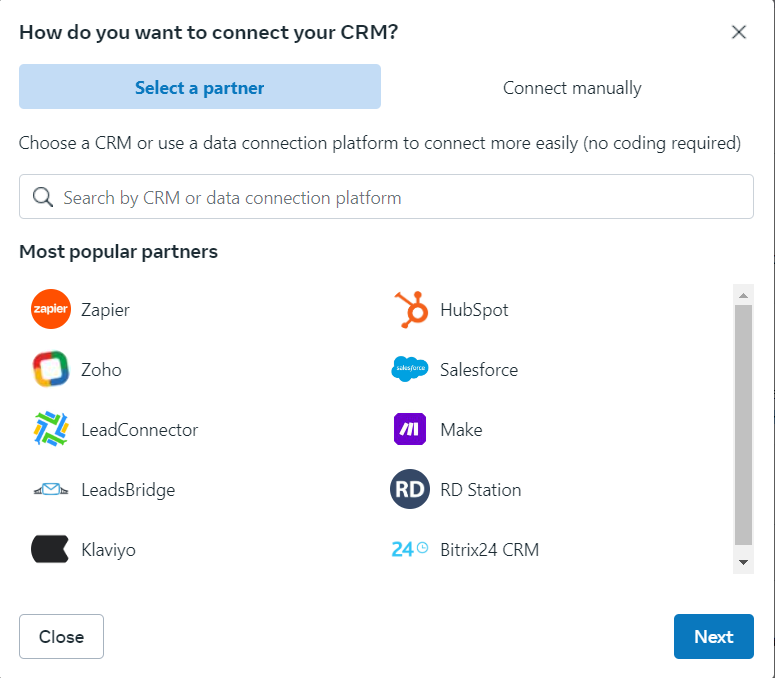
Analysing Dataset Performance
- Navigate to Ads Manager and select the desired level (campaigns, ad sets, or ads).
- Click ‘View Charts’ for visual performance data.
- Review metrics on Performance, Demographics, Placement, or Delivery to gain insights into your ad effectiveness.
Summary
Adopting Facebook’s advanced datasets marks a transformative advancement in advertising technology, empowering marketers with deeper insights for more effective campaign management and optimisation. By integrating these datasets with CRM systems, advertisers gain a holistic view of customer interactions, enhancing every touchpoint from initial contact through to post-sale activities. This integration is crucial for optimising ad delivery based on quality leads rather than sheer volume, leveraging Facebook Ads AI to fine-tune targeting deeper in the sales funnel.
Throughout this guide, we have examined how CRM funnel events can significantly refine ad delivery, improving both lead quality and the overall return on investment. As advertisers harness the full potential of these data tools, they can drive more efficient campaigns and achieve better market outcomes, ensuring sustained growth and success in the competitive digital advertising landscape.